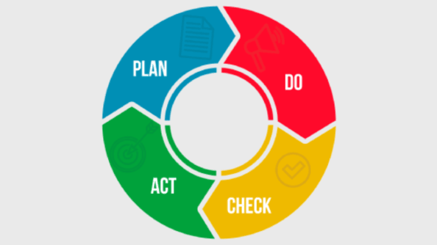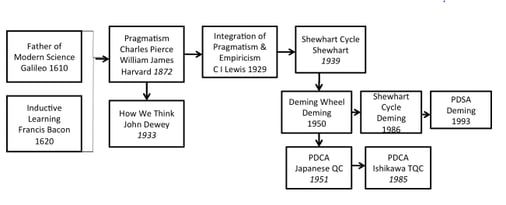For a business to grow over the years it must be in a state of continuous improvement. New process or activities will be added to the process and improvement must not be stale. Plan-Do-Check-Act cycle is a model for carrying out change. It is an essential part of the lean manufacturing philosophy and a key pre-requisite for continuous improvement of people and processes.

History of PDCA Cycle:
PDCA, sometimes called PDSA, the "Deming Wheel," or "Deming Cycle," was developed by renowned management consultant Dr William Edwards Deming in the 1950s. Deming himself called it the "Shewhart Cycle," as his model was based on an idea from his mentor, Walter Shewhart. Shewhart himself developed it from various researches before him. A history flow below shows it

Deming wanted to create a way of identifying what caused products to fail to meet customers' expectations. His solution helps businesses to develop hypotheses about what needs to change, and then test these in a continuous feedback loop.
- By This Deming used the concept of Plan-Do-Study-Act (PDSA).
- He found that the focus on Checkis more about the implementation of a change.
- Deming's focus was on predicting the results of an improvement effort, studying the actual results, and comparing them to possibly revise the theory.
- He stressed that the need to develop new knowledge, from learning, is always guided by a theory.
What is PDCA and how it works
- It is an approach to continuously improve Product,People and Services
EXAMPLE: Imagine that you have plenty of customer’s complaints about slow response rate of your support team. Then you will probably need to improve the way your team works in order to keep customers satisfied. That is the point where PDCA comes into play.
So lets look at each phase and how it works
PLAN:
It is imperative to build a proper plan(possibly with the whole team) for lesser possibilities of failure.Steps here are
- Identify the problem
- Collect relevant data, and understand the problem's root cause
- Develop hypotheses about what the issues may be and
- Decide which one to test.
As this is a very important phase ask yourself have you answered the major concerns
- What is the core problem we need to solve?
- What resources do we need?
- What resources do we have?
- What is the best solution for fixing the problem with the available resources?
- In what conditions the plan will be considered successful? What are the goals?
After this move to the next phase of DO
DO:
After the Team has agreed on a plan,
- Develop and implement a solution;
- Decide upon a measurement to gauge its effectiveness,
- Test the potential solution
- Measure the results.
There may be unpredicted problems which may occur and so implement the plan on a small scale and check the result.
CHECK:
This is probably the most important stage of the PDCA cycle.
If you want to clarify your plan, avoid recurring mistakes and apply continuous improvement successfully, you need to pay enough attention to the CHECK phase.
Steps you do here are
- Confirm the results through before-and-after data comparison.
- Study the result, measure effectiveness, and decide whether the hypothesis is supported or not
On finding the faults, eliminate them from the future process
ACT:
If everything seems perfect and we have achieved the original goal, then we can proceed and apply the plan
By this
- Document the results, inform others about process changes, and make recommendations for the future PDCA cycles.
- If the solution was successful, implement it. If not, tackle the next problem and repeat the PDCA cycle again
ADVANTAGES:
- It stimulates continuous improvement of people and processes.
- It lets your team test possible solutions on a small scale and in a controlled environment.
- It prevents the work process from recurring mistakes.
Further Reading and References:









